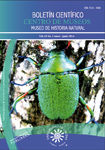Authors
Abstract
In the tropics, frugivorous and nectarivorous bird species'richness and abundance differs between forest plantations and native forests. Such trophic structure differences emerge from the limitations that forest plantations has as habitat for these bird species. Hence, understanding how trophic guild differences emerge among habitat types is a key factor for establishing the actual conservation value of forest plantation for avifauna conservation. We compared understory frugivorous and nectarivorous birds' richness and abundance between an Andean alder (Alnus acuminata) plantation and a second-growth forest stands, located at the Colombian Central Andes. We based comparisons on mist-net captures during seven months of sampling (October 2008 - April 2009). Greater nectarivorous abundance and frugivorous species richness was detected at the alder plantation; between-habitat similarity was low, suggesting that these habitats are not equivalent for avifauna. Such differences could be associated to factors as vegetation structure differences, understory floristic composition, and resource offer as has been registered for other forest plantations elsewhere. In summary, our results suggests that alder plantation's understory have no negative effect on frugivorous and nectarivorous birds, and also it might have a complementary ecological role in maintaining the species richness of these bird guilds at the study region.
References
BLAKE, J.G. & LOISELLE, B.A., 1991. Variation in resource abundance affects capture rates of birds in 3 lowland habitats in Costa Rica. Auk, (108):114-130.
CASTAÑO-VILLA, G.J. & PATIÑO, J.C., 2008. Extinciones locales de aves en fragmentos de bosque en la región de Santa Helena, Andes Centrales, Colombia. Hornero, 23(1): 23-34.
CAVELIER, J. & SANTOS, C., 1999. Efectos de plantaciones abandonadas de especies exóticas y nativas sobre la regeneración natural de un bosque montano en Colombia. Rev. Biol. Trop., 47(4): 775-784.
COCKLE, K.L., LEONARD, M.L. & BODRATI, A.A., 2005. Presence and abundance of birds in an Atlantic forest reserve and adjacent plantation of shade-grown yerba mate, in Paraguay. Biodiv. Conserv., (14):3265-3288.
DURÁN, S. & KATTAN, G.H., 2005. A test of the utility of exotic tree plantations for understory birds and food resources in the Colombian Andes. Biotropica, 37(1):129-135.
FARIA, D., LAPS, R.R., BAUMGARTEN, J. & CETRA, M. 2006. Bat and bird assemblages from forests and shade cacao plantations in two contrasting landscapes in the Atlantic Forest of southern Bahia, Brazil. Biodiv. Conserv., (15): 587-612.
GOTELLI, N.J. & COLWELL, R.K., 2001. Quantifying biodiversity: procedures and pitfalls in the measurement and comparison of species richness. Ecol. Lett., (4): 379-391.
GOTELLI, N.J. & ENTSMINGER, G.L., 2007. EcoSim: Null models software for ecology, version 7.0. Acquired Intelligence Inc. & Kesey-Bear. Available online at http://homepages.together.net.
HAMMER, Ø., HARPER, D.A.T. & RYAN, P.D., 2001. PAST: Paleontological Statistics Software Package for Education and Data Analysis. Palaeontol. Electron., 4(1):1-9.
HOLBECH, L.H., 2009. The conservation importance of luxuriant tree plantations for lower storey forest birds in south-west Ghana. Bird Conserv. Int., (19): 287-308.
KARR, J.R., 1981. Surveying birds with mist nets. Stud. Avian Biol-Ser., (6): 62-67.
LENTIJO, G.M. & KATTAN, G.H., 2005. Estratificación vertical de las aves en una plantación monoespecífica y en bosque nativo en la Cordillera Central de Colombia. Ornitología Colombiana, (3): 51-61.
LINDENMAYER, D.B. & FRANKLIN, J.F., 2002. Conserving Biodiversity: A Comprehensive Multiscaled Approach. Island Press, Washington DC.
LINDENMAYER, D.B. & HOBBS, R.J., 2004. Fauna conservation in Australian plantation forests – a review. Biol. Conserv., (119): 151-168.
MENDOZA-S, J.E., LOZANO-ZAMBRANO, F.H. & KATTAN, G., 2006. Composición y estructura de la biodiversidad en paisajes transformados terrestres en Colombia: 67-84 (en) CHÁVES, M.E. & SANTAMARÍA, M. (eds.) Informe sobre el avance del conocimiento y la información de la biodiversidad 1998-2004. Instituto de Investigación de Recursos Biológicos Alexander von Humboldt. Bogotá D.C. Colombia.
MURCIA, C., 1997. Evaluation of Andean alder a catalyst for the recovery of tropical cloud forests in Colombia. Forest Ecol. Manag., (99): 163-170.
MYERS N, MITTERMEIER RA, MITTERMEIER CG, DA FONSECA GAB, KENT J. 2000. Biodiversity hotspots for conservation priorities. Nature, 403: 853-858.
ORTIZ-PULIDO, R., 2000. Abundance of frugivorous birds and richness of fruit resource: is there a temporal relationship? Caldasia, (22): 93-107.
PANGEA, 2006. Formulación plan de conservación de biodiversidad y aprovechamiento ecoturístico Reserva Forestal de la CHEC. Manizales. Central Hidroeléctrica de Caldas S.A. E.S.P.
RAMOS, F.A., 2010. Estructura y composición florística de un bosque secundario y una plantación de aliso (Alnus acuminata), en los Andes Centrales Colombianos: Tesis, Universidad de Caldas. Facultad de Ciencias Exactas y Naturales, Manizales.
RENJIFO, L.M., 2001. Effect of natural and anthropogenic landscape matrices on the abundance of Subandean bird species. Ecol. Appl., 11(1): 14-31.
REMSEN JV, CADENA CD, JARAMILLO A, NORES M, PACHECO JF, PÉREZ-Emán J, ROBBINS MB, STILES FG, STOTZ DF, ZIMMER KJ. Version 4 Mar. 2010. A classification of the bird species of South America. American Ornithologists' Union. http://www.museum.lsu.edu/~Remsen/SACCBaseline.html
SARACCO, J.F., COLLAZO, J.A., GROOM, M.J. & CARLO, T.A., 2005. Crop size and fruit neighborhood effects on bird visitation to fruiting Schefflera morototoni trees in Puerto Rico. Biotropica, (37): 80-86.
STATSOFT INC. 2004. STATISTICA (data analysis software system), version 7. http://www.statsoft.com.
STATTERSFIELD, A.J., CROSBY. M.J., LONG, A.J. & WEGE, D.C., 1998. Endemic bird Areas of the World: Priorities for Biodiversity Conservation. BirdLife Conservation Series 7. Cambridge: BirdLife International, UK.
TERBORGH J. 1985. Habitat selection in Amazonian birds: 311-338 (en) CODY, M.L., (ed.) Habitat Selection in Birds. Academic Press Inc., New York.
VOLPATO, G.H., PRADO, V. & DOS ANJOS, L., 2010. What can tree plantations do for forest birds in fragmented forest landscapes? A case study in southern Brazil. Forest Ecol. Manag., (260): 1156–1163.
WATLING, J.I. & DONNELLY, M.A., 2008. Species richness and composition of amphibians and reptiles in a fragmented forest landscape in northeastern Bolivia. Basic Appl. Ecol., 9(5): 523-532.

 PDF (Español)
PDF (Español)
 FLIP
FLIP


















